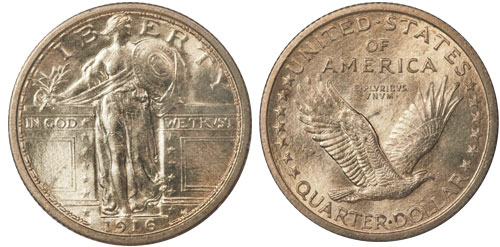Background and History
The 1916 Standing Liberty Quarter (Buy on eBay) is an important key date coin, with its rarity resulting from both the extremely limited mintage and the circumstances of its release. Representing the first year of issue for the new series designed by Hermon A. MacNeil, the entire mintage of just 52,000 pieces was released into circulation with little notice given to the design change. By the time the rarity of the issue was realized, very few pieces had been saved and the coin was extremely scarce in uncirculated condition.

The quarter dollar was one of three silver denominations to receive a new design in 1916, replacing the previous designs by Charles E. Barber which had been in use since 1892. The designs for the denominations would be chosen through a competition, which was relatively unheard of at the time. Hermon A. MacNeil would submit the winning design for the quarter, while Adolph A. Weinman would take the honors for both the dime and half dollar.
MacNeil’s work on the quarter design would take most of 1916, and various sketches of his ideas are known along with a small number of struck patterns. The obverse would feature a woman representing Liberty, stepping forward through an opening in a gate, or in MacNeil’s words “to the gateway of the country.” The reverse would feature an eagle in flight, perhaps inspired by the Gobrecht Dollars of the 1830’s. Other features included an olive branch and shield held by Liberty on the obverse and a pattern of stars surrounding the eagle on the reverse.
The obverse also had a feature which numismatic lore often states was criticized by the public. This was the partially exposed breast of Miss Liberty, unseen on any other previous American coinage. Many sources state that MacNeil would modify the design in response to the public outcry. These modifications included covering up Liberty on the obverse and rearranging the stars on the reverse. Modern research, however, has shown that MacNeil made the changes because he was not satisfied with his work and wanted to adjust the design to his tastes.
Production of the original design would commence in the final weeks of 1916 at the Philadelphia Mint. By this time, it was too late to ship the 1916-dated dies to the branch mints or to strike a reasonable number of quarters. Perhaps without realizing it, the Mint created a rarity which would later find much demand from collectors.
Coin Mintage
During the final two weeks of the year, a total of 52,000 1916-dated Standing Liberty Quarters were struck by the United States Mint in Philadelphia. It seems that not much news coverage was initially devoted to the change in design (this would occur later in various newspapers, where the design was carefully studied and the exposed breast was noted) and the coins quietly entered circulation. Soon, 1916 had passed into 1917, and the obverse dies were replaced to reflect the new date.
Around this time, many individuals had taken up the habit of setting aside examples from the first year of production for a new coin series. In this instance, it is generally assumed that the public set aside the 1917-dated coins, while the 1916-dated coins circulated freely. This was the result of the lack of attention given to the change in design upon its initial limited release.
In the ensuing decades as coin collecting grew more popular, awareness of the 1916 Standing Liberty Quarter increased and people began searching for the rare issue in their pocket change. By this time, most were in circulated condition and only a handful of examples had been fortunate enough to escape such a fate. The low survival rate particularly for uncirculated examples has helped enhance the rarity of this key date and solidify its importance within American numismatics.
Finest Known and Values
The single finest known example of the 1916 Standing Liberty Quarter has been graded by PCGS as MS-67+ FH. This narrowly exceeds the grade of five examples graded by PCGS and four examples graded by NGC as MS-67 FH (without the plus). Across the two services, there are approximately 40 coins graded MS-66 FH, followed by approximately 140 coins graded MS-65 FH. There are additionally about 60 examples in grades ranging from MS-65 to MS-67 without the “FH” designation. As always, these figures may be influenced by resubmissions motivated by the large price differences that can exist between grades.
Eye-appeal is very important when determining the value of 1916 Standing Liberty Quarters. Original toned examples usually sell for a premium. The “FH” or “Full Head” designation, indicating a specimen with fully struck details of Liberty’s hair and face, also drives a significant premium. The highest price paid for a coin of this issue was for an example graded PCGS MS-67 FH with CAC verification, which sold for $195,500 at auction in 2010. Other auction results for NGC coins in the same grade include prices of $97,750 in 2006 and $74,750 in 2007. The highest price realized for a certified example without the Full Head designation was for an NGC MS-67 piece which sold for $40,250 in 2006.
Because of the low mintage and high demand for this issue, even heavily circulated examples sell for at least a few thousand dollars, with price levels increasing sharply for moderately circulated coins. Many of the lower grade coins will only have a partial date, with some coins only having part of the digit “6” visible.

